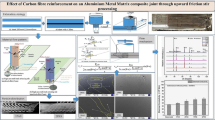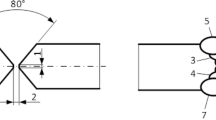Abstract
Experimental method for evaluation of residual stress distribution in carbon fiber reinforced carbon composite jointed to copper is presented. Pulse electric current passed through composite-to-copper joint essentially reduces the level of residual stresses.
Similar content being viewed by others
References
Yu. V. Baranov, O. V. Troitskii, Yu. S. Avraamov, and A. D. Shlyapin, Physical Grounds of Electric Pulse and Electric Current/Plasic Treatments and New Materials [in Russian], MGIU, Moscow (2001).
A. F. Sprecher, S. L. Mannan, and H. Conrad, “On the mechanisms for the electroplastic effects in metals,” Acta Metal., 34, No. 7, 1145–1162 (1986).
G. V. Stepanov, A. I. Babutskii, I. A. Mameev, and A. N. Olisov, “Analysis of pulse current-induced tensile stress relaxation,” Strength Mater., 38, No. 1, 84–91 (2006).
V. A. Boguslaev, A. I. Dolmatov, P. D. Zhemanyuk, et al., Life Prolongation of Gas Turbine Disk Titanium Alloy Parts [in Russian], Zaporozhye (2000).
A. D. Glinberg, N. A. Karandashev, A. F. Krutin, and E. N. Sidorenkov, “Practics and perspectives of application of magnetic-pulse treatment of metals,” in: Proc. Int. Conf. on Action of Electromagnetic Fields and Electric Current on Metals (October 21–24, 2003), Moscow (2003), pp. 55–57.
M. Merola, M. Akiba, V. Barabash, and I. Mazul, “Overview on fabrication and joining of plasma facing and high heat flux materials for ITER,” J. Nucl. Mater., 307–311, 1524–1532 (2002).
N. Eustathopoulos, M. G. Nicholas, and B. Drevet, Wettability at High Temperature, Pergamon Press (1999).
P. Appendino, M. Ferraris, V. Casalegno, et. al., “Direct joining of CFC to copper,” J. Nucl. Mater., 329–333, 1563–1566 (2004).
P. Appendino, M. Ferraris, V. Casalegno, et al., “Proposal for a new technique to join CFC composites to copper,” J. Nucl. Mater., 348, No. 1–2, 102–107 (2006).
G. S. Schajer and M. B. Prime, “Use of inverse solutions for residual stress measurement,” J. Eng. Mater. Technol., 128, No. 3, 375–382 (2006).
G. V. Stepanov, A. I. Babutskii, and I. A. Mameev, “High-density pulse current-induced unsteady stress-strain state in a long rod,” Strength Mater., 36, No. 4, 377–381 (2004).
Author information
Authors and Affiliations
Additional information
__________
Translated from Problemy Prochnosti, No. 4, pp. 79–86, July–August, 2008.
Rights and permissions
About this article
Cite this article
Stepanov, G.V., Babutskii, A.I., Mameev, I.A. et al. Experimental evaluation of pulse electric current effect on residual stresses in composite-to-copper joints. Strength Mater 40, 452–457 (2008). https://doi.org/10.1007/s11223-008-9055-6
Received:
Published:
Issue Date:
DOI: https://doi.org/10.1007/s11223-008-9055-6




